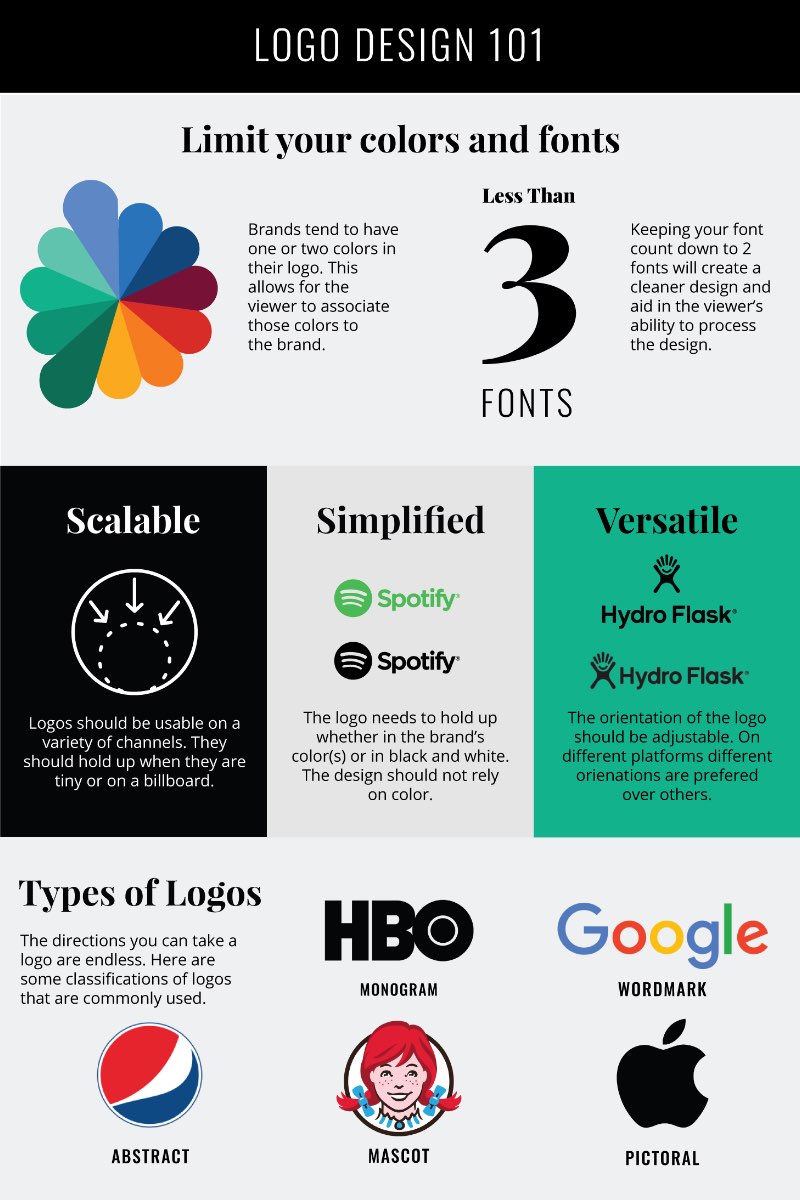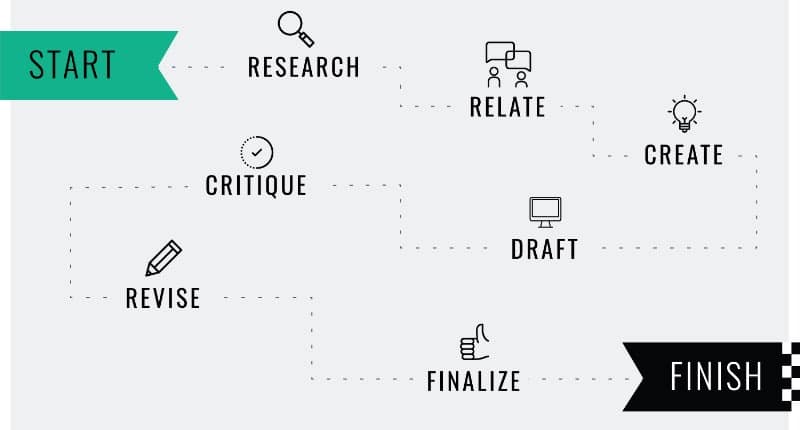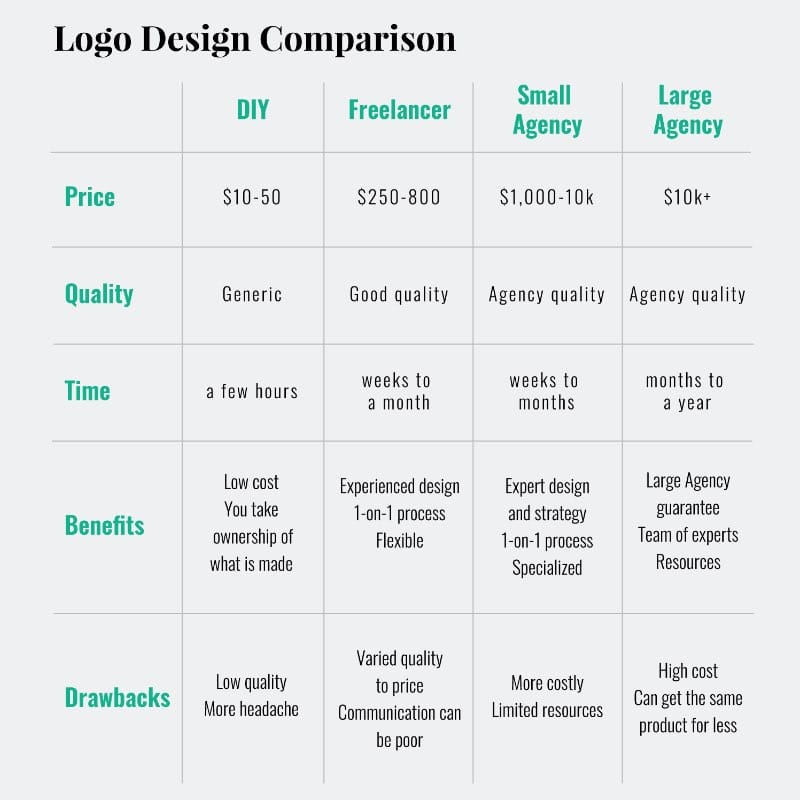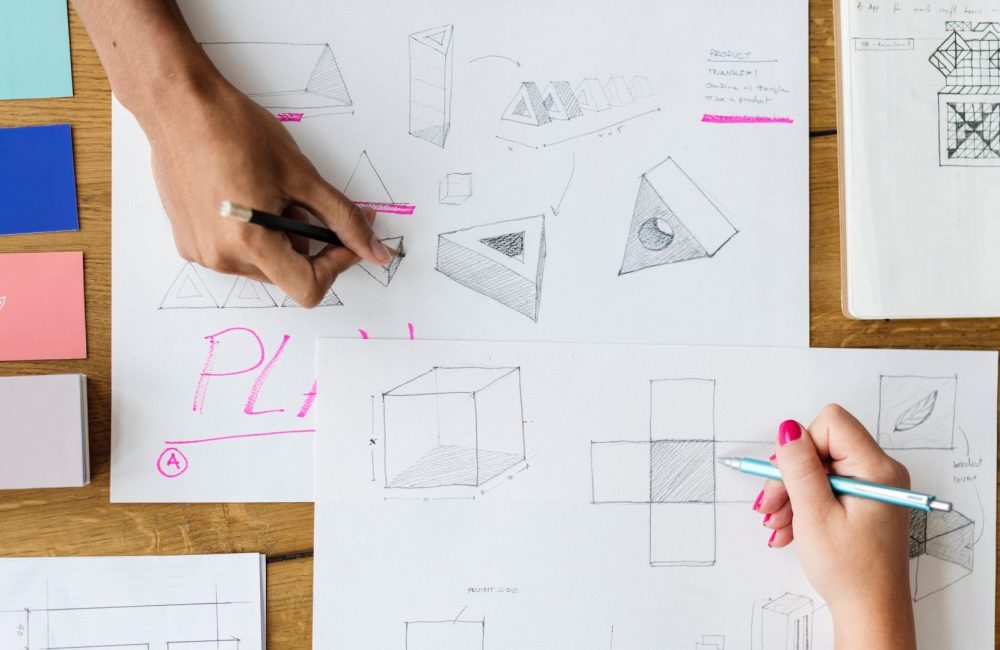Logo Design Basics
An effective logo can help a brand gain, retain, and engage customers. There is no exact science to logos, but in the hands of a great designer, magic can happen. There are a variety of guidelines that designers keep when creating a logo. The logo must be simple, flexible, eye-catching, and representative.
Minimal logo designs are more powerful than complicated ones. With a simple design, the message of the brand is delivered in an impactful way with clarity for the customer. Designers achieve simplicity by limiting things like the number of fonts and colors used. A simpler design also adds to the utility of a logo.
Flexibility is also key to a good logo. With many companies needing their logos on a variety of different mediums, logos have their work cut out for them. Whether it is on social media, a t-shirt design, giant banners, or tiny business cards, logos have to be scalable and versatile.

The main purpose of a logo is to be the identifying mark of a company. It must represent the culture, product/services, and goals of the brand. The imagery needs to avoid being cliche but also has to represent the industry the company is in. Industries such as real estate have seemingly standardized imagery. While standardization helps distinguish those within the industry, no one stands out since every logo looks the same. The key is to stay away from those well-established trends within the industry and find unique, representative imagery.
What is the Process?
The logo design process involves various steps leading to the end product that, if all goes well, is a representation of the company’s brand.

Prior to any design work, extensive research will be done to gain perspective of the project. The designer will research the company, industry, and target customer. This research can take many forms whether it is online or just in the real world observing.
Most designers will do initial brand research before meeting with the client. When meeting with the client they will extract any and all information surrounding the company’s brand. This includes culture, goals, value proposition, customer base, competitors, and taste. After meeting with the client, the designer will have a full “profile” of the company itself. Once a company “profile” is created, additional visual research will be done based on the imagery the initial meeting suggested.
After the initial research phase, the designer will begin creating ideas. He or she will sketch the various directions the logo could go and will present those final sketches. Each sketch will be a rough representation of imagery and can vary in detail. The client then will assess the sketches and decide which direction they would like to go. Depending on the client/designer relationship this portion can be collaborative and involve a lot of brainstorming to find the best solution for the client’s goals.
Once a direction is decided, the designer will begin drafting ideas. He or she will take those sketches that had elements the client wanted and digitize them. This design tends to be devoid of color and sometimes even fonts in order to get a clear direction for the logo.
The designer will then meet with the client and the digital drafts will go through initial revisions. During this meeting, it is important to keep clear communication. At this point, both parties are heavily invested, therefore, making sure that feedback is constructive is necessary to the creation of a good logo. After the initial revisions, the designer will refine the design. They will apply the critiques and add color while creating variations of the logo.
The logo will then go through more tweaks and revisions until the agreed-upon final product is finished. Depending on the package the client agreed to, the designer will build a style guide for the logo. This style guide can vary depending on need but will include typefaces, colors, and sometimes other design pieces like icons. The style guide is a fully comprehensive guide on how to leverage the new branding.
How Long Should it Take?
The length of a logo project can vary from a few hours, to weeks, or to more than a year. When a contract is signed for a logo, the timeline will be outlined. This will keep both parties accountable for moving the process along.

If you are short on time and budget, it may be a good option to create your own logo. When creating your own logo, the process can be a matter of hours before you have a logo. If you use a logo builder you will not have to design vectors yourself and will, in turn, save time and money.
For a smaller brand package, the process can take a few weeks. Generally, this means the logo did not go through many revisions and did not require other pieces of collateral. Companies that tend to have only a few weeks for a logo project are smaller with a smaller logo budget. For the most part, the longer a logo project takes the higher the price tag is because time can be directly correlated to the number of revisions. In order to have a shorter timeline, clients should have a good idea of what they want and have found a designer with aligning styles and design thinking.
Long term logo design processes point to a higher number of revisions and a bigger stake for the logo design itself. A company needing this timeline for the process is larger and has a larger budget. This type of company has a higher stake on the success of the logo and will want to spend more time refining it. For these companies, the logo exists on a wide array of mediums and it can be a large investment to change a logo.
Another instance of a logo design process taking a year is if the client does not have clearly defined goals or if there is poor communication. Without a clear heading, a designer will have to present the client with various ideas many of which will go through revisions. Poor communication is a result of both parties being unable to share an understanding. This can cause issues in the critique and revision process, resulting in an increase in revisions.
How Much Should it Cost?
A challenge for many logo designers is pricing something that varies in value. For a startup, a logo change may not cost that much. But for a large corporation, a logo change means thousands sometimes millions of dollars in costs just to align their products to the new brand. The value a logo holds varies from client to client, therefore, so does the price.
Nike has, arguably, one of the most iconic logos. As a well-established company that swoosh holds a lot of value for the company. However, when created, it cost the company $35. Why? It was designed by a graphic design student and the co-founder Phil Knight didn’t love it. At that point in time, the swoosh held a low value for the company and the cost reflected that. (In the eighties, the design student was later compensated for the value the swoosh held for the company in an undisclosed amount.)
How do you then put a price on something that can vary so much in value? The first way designers do this is by assigning a value to it. Rather than charging an hourly rate, many designers will evaluate their experience and the value a logo would give to the company. Generally, there isn’t a correlation to the amount of time taken to design a logo and the quality of the end result. Also as a client, the goal is to receive great quality in a limited amount of time and within budget.
All in all, logos can range in price from ten to thousands of dollars depending on the value and where you get them.
Who Should Design Your Logo?
Deciding what the best path is for your logo is a daunting process. With so many options and directions, it can be overwhelming. For the most part, there are four different options for logo design: junior freelancer, senior freelancer, marketing agency, or DIY.

Here are some tips on deciding what is the best fit for your company:
- Do you need it to just stand as a placeholder? Do you need it quickly and with minimal expense? Go for the cheaper logo makers and do it yourself. It will be a lower investment and once you need a more professional logo you won’t have a large sum invested in the old logo.
- Do you want a long-lasting and quality logo but don’t have the funds to dish out thousands of dollars? Take your project to a freelancer. They are still a professional but are many times cheaper than an agency.
- Do you want a logo that will help you stay in the vanguard of your industry and have the budget to do so? Hire an agency. You will have an agency back logo created by industry experts. Their resources will also help you with a lot more than just a logo and many times will give you the feeling of a well-rounded brand.
Tips & Tricks
Whether you are making your own logo or hiring a designer or agency to, here are some helpful tips on how to best approach the process.
- Know your company’s value proposition, objectives, and message
- Understand your audience
- Do your research (have a basic understanding of the visual direction you want)
- Have a clear scope of the project (budget, timeline, and expectations)
Clearly outlining all of these things before looking to design a logo will move the process along smoother and will result in a logo that you can be proud of.
DIY Logo Design
If you’ve decided that professional help is not the best fit for your company, designing your own can be a viable option. There are plenty of tools and resources online that will guide you through the process. Here are some steps you can take to succeed in making your own logo.
Step 1
Watch youtube videos about logo design fundamentals.
Here is a video that may be a good start: https://www.youtube.com/watch?v=l-S2Y3SF3mM&list=PLx03_0RRvUEE8w_ipVLwBjr9glIlU9G8M&index=6
Step 2
Research other logos within your industry as well as ones that use imagery you would like to incorporate.
Step 3
Create Rough versions of your logo. This can be through sketching or just playing with logo maker websites.
Step 4
Create your logo. Here are some builders that might be helpful:
Step 5
Ask for Feedback. Show your logo to people that you trust and that have a good idea of what your business goals are. Know what feedback is important and what is a matter of subjectivity.
Conclusion
It is important to understand the weight a good logo holds for a company. It can help propel a company into success, or if it is poorly executed, it can mar the company’s image. Logo design is not a defined science but with innovative design thinking and processes, the end result can make a world of a difference for a company.
https://ebaqdesign.com/blog/logo-design-process/
https://blog.hubspot.com/marketing/creating-logos-design-process
https://justcreative.com/2017/06/28/logo-design-tips-for-small-business-owners/
https://99designs.com/blog/logo-branding/how-to-create-logo/
https://www.highsnobiety.com/2012/08/15/the-cost-of-a-logo-nike-coca-cola-london-2012/
